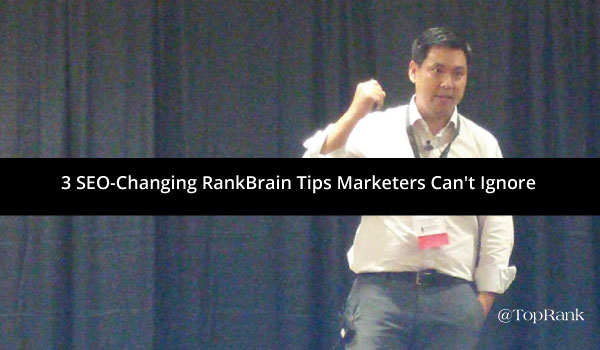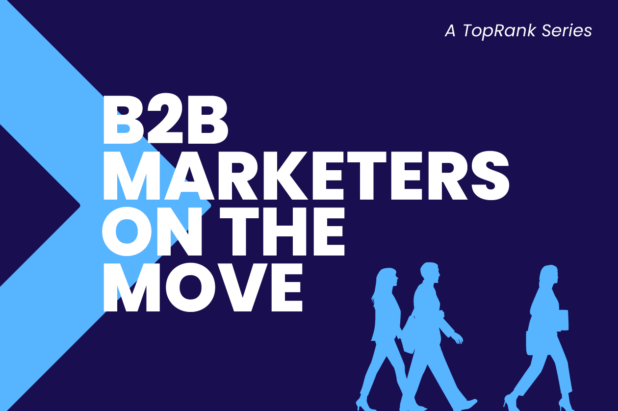
The way that marketers think about, talk about and implement SEO is constantly evolving. Blackhat SEO tactics that once were incredibly successful, no longer garner the results that they once did. Both search engines and online audiences have become much more sophisticated, forcing marketers to ditch the slimy SEO tactics and focus instead on providing real value.
According to TNW News, 47% of digital marketers name SEO as one of their most effective tactics, but 39% also identify it as one of the most difficult.
To help ease the pain, I attended a presentation last week by WordStream’s Larry Kim that shone a light on why the traditional workflow of which includes inserting keywords in the “right” places needs to change. The presentation included what Google’s RankBrain actually is and why it matters, but the bulk of the talk dug into how to change focus in the face of algorithm changes like RankBrain and why exact term usage needs to be less of a focus moving forward. Read on to get 3 tips on where to focus your SEO efforts instead.
What is RankBrain?
Larry stated that “it doesn’t matter if RankBrain is an addition to the algorithm or an alteration. What matters is whether the change effects what content ranks”. In the case of RankBrain, this change certainly does matter.
RankBrain enables the interpretation of meaning. The interpretation of the meaning behind keyword searches and the interpretation of the meaning behind language used in meta, on-page, and site-wide. Beyond this, RankBrain learns about what content (and what types of content) appeals to specific search audiences in order to provide more useful, relevant search results.
Why Does it Matter?
Google being able to interpret the meaning of language used online makes a big difference. It means it’s easier to get your content indexed for relevant keywords, as long as that content is relevant to the search intent behind the keyword. It means inserting keywords isn’t a priority anymore – exact keyword usage does not make it easier to become indexed.
So, if we’re already indexed for the keywords we want to rank for, how do we rank? Here’s 3 tips from Larry Kim on how to switch focus away from keyword usage and indexation, and toward tactics that take advantage of the sophisticated qualities of RankBrain and how it measures and scores content quality to determine rank position.
Tip #1: Stop Inserting Keywords into Your Meta Titles
There is a negative correlation between exact keyword inclusions and CTR. High performing meta titles (above the average click-through rate at the given position) actually tend to not include the exact keyword. This is because RankBrain enables interpretation of the meaning behind language: interpretation of both the language used in the keyword search, along with the language used on-page and in meta.
Don’t Forget: align your meta message to speak to the intent of the search audience you’re targeting in order to encourage searchers to click your result. Inserting keywords is not important, and can actually be a disadvantage.
Tip #2: Remember What Actually Impacts CTR
So, you might be wondering: if I’m not supposed to insert keywords into my meta title, what am I supposed to do what it? Great question, here is some:
Use Emotional Triggers
Write headlines to an emotional persona based on basic emotional triggers: anger, urgency, fear, sadness, etc. By appealing to the emotions of your audience in a unique, catchy way, you can encourage them to click on your meta title for more.
Test with Paid
The best way to test your meta click-ability is to use AdWords to test 10 different headlines for different emotional personas. It’s a quick-and-easy 2 step process:
- Step 1: Use broad match keywords to represent the variety of exact keywords that relate to the search audience you wish to reach
- Step 2: Replace old headlines with the winner
Be Memorable, Become Familiar
Another important factor to consider is how “non-SEO” tactics actually make a huge impact on CTR from the SERP by creating a familiarity bias. Stated simply, this bias goes like this: if you’re familiar with a brand before you search, you’re more likely to click on their result. I’ll break down his advice into 2 steps to create brand familiarity in order to dramatically improve organic CTR:
- Step 1: create familiarity with the brand by drawing people in with memorable, useful content that doesn’t try to sell anything.
- Step 2: Ensure subsequent searches go your way by remarketing your most memorable content.
Tip #3: Focus on Engagement
Bounce Rate
Another highly impactful factor to rank is bounce rate. There are correlations that we see in nature that are non-causal, and there are correlations we see with algorithm inclusions. The correlation between bounce rate and rank looks very algorithmic. That being said, bounce rate is the #1 indicator that searchers aren’t liking your content. Focusing on providing additional useful links to more content is a great way to reduce bounce rate and start sending positive signals to Google about the quality of your content.
Dwell Time (bounce + time spent)
The metrics Google uses to determine whether or not content is satisfying searchers are also important. Some of these metrics are not accessible to marketers with Google Analytics. An example of this is dwell time. This is the time between when searchers enter the page from the SERP and how long they dwell on the page before bouncing back to the SERP. The advice Larry gave for leveraging this information is to use the combination of time spent on page and bounce rate to determine how well the page is measuring up against Google’s dwell time metric.
Conversion Rates
Conversion rate implies content appeal too, of course. Larry’s tip: change your offer dramatically to increase conversion rate if you’re not finding success. Honing your focus on conversion rate optimization isn’t just great for appealing to your audience at the bottom of the funnel, it’s great for attracting customers through search visibility across the entire funnel as well.
Poor Performing Content
If you can’t fix it, delete it. If you have consistently poor performing content, you should “delete your bad neighborhoods”. This is because studies that look at the relevance of domain authority vs page authority for determining rank strong suggest a domain-level engagement “score”, as well as a page-level engagement “score”. If you have content that performs badly and doesn’t provide value to users, this is content that will only negatively impact what your content quality looks like at the domain level.
Key Take-Away: New Rank Factors to Replace the Focus on Keyword Usage
Larry talked a lot about CTR from the SERP in his presentation. He brought up an important question: what came first, rank or CTR? The answer is they are reciprocal. Where top rank position impacts CTR, CTR also is measured and plays a part in determining rank position. But the reason he makes this point is to demonstrate that Google is measuring what implies searcher satisfaction. CTR is just one of these measurements. Once content is indexed, CTR is not the only thing that represents content quality. How searchers behave and engage with content after they enter a website from the SERP plays a huge role in the checks and balances of identifying truly useful content for searchers.
So if you’re going to remember one thing about RankBrain: it’s easy to get indexed, but make sure you’re appealing to the search audience and their intent from SERP to site.


